
Over 16,556,443 people are on fubar.
What are you waiting for?

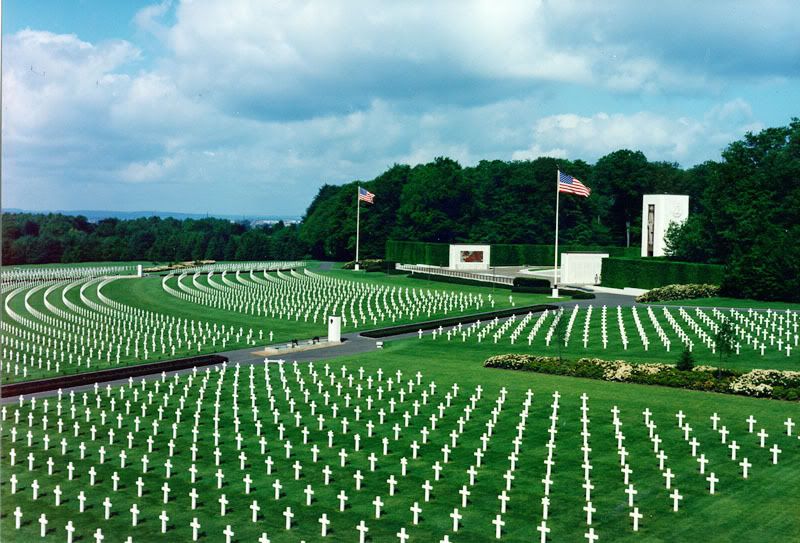 The Luxembourg American Cemetery and Memorial, 50.5 acres in extent, is situated in a beautiful wooded area. The cemetery was established on December 29, 1944 by the 609th Quartermaster Company of the U.S. Third Army while Allied Forces were stemming the enemy's desperate Ardennes Offensive, one of the critical battles of World War II. The city of Luxembourg served as headquarters for General George S. Patton's U.S. Third Army. General Patton is buried here.
Not far from the cemetery entrance stands the white stone chapel, set on a wide circular platform surrounded by woods. It is embellished with sculpture in bronze and stone, a stained-glass window with American unit insignia, and a mosaic ceiling. Flanking the chapel at a lower level are two large stone pylons upon which are maps made of various inlaid granites, with inscriptions recalling the achievements of the American armed forces in this region. On the same pylons are inscribed the names of 371 of the missing. Rosettes mark the names of those since recovered and identified.
Sloping gently downhill from the memorial is the burial area containing 5,076 of our military dead, many of whom lost their lives in the "Battle of the Bulge" and in the advance to the Rhine. Their headstones follow graceful curves; trees, fountains and flower beds contribute to the dignity of the ensemble.
The cemetery is open daily to the public from 9 a.m. to 5 p.m. except December 25 and January 1. It is open on host country holidays. When the cemetery is open to the public, a staff member is on duty in the Visitor Building to answer questions and escort relatives to grave and memorial sites.
How to Get There
Luxembourg American Cemetery lies in Hamm just 3 miles east of downtown Luxembourg City. It can be reached by train from Paris (Gare de l'Est) in approximately 4 hours. The cemetery can also be reached from neighboring countries via E25/E44, exiting at Exit 7 clearly marked "Cimetières Militaires" (Military Cemeteries). The airport is three miles northeast of the cemetery. Taxicabs are available at the Luxembourg station and airport and bus service is available from the city. There are excellent hotels in the city.
The Luxembourg American Cemetery and Memorial, 50.5 acres in extent, is situated in a beautiful wooded area. The cemetery was established on December 29, 1944 by the 609th Quartermaster Company of the U.S. Third Army while Allied Forces were stemming the enemy's desperate Ardennes Offensive, one of the critical battles of World War II. The city of Luxembourg served as headquarters for General George S. Patton's U.S. Third Army. General Patton is buried here.
Not far from the cemetery entrance stands the white stone chapel, set on a wide circular platform surrounded by woods. It is embellished with sculpture in bronze and stone, a stained-glass window with American unit insignia, and a mosaic ceiling. Flanking the chapel at a lower level are two large stone pylons upon which are maps made of various inlaid granites, with inscriptions recalling the achievements of the American armed forces in this region. On the same pylons are inscribed the names of 371 of the missing. Rosettes mark the names of those since recovered and identified.
Sloping gently downhill from the memorial is the burial area containing 5,076 of our military dead, many of whom lost their lives in the "Battle of the Bulge" and in the advance to the Rhine. Their headstones follow graceful curves; trees, fountains and flower beds contribute to the dignity of the ensemble.
The cemetery is open daily to the public from 9 a.m. to 5 p.m. except December 25 and January 1. It is open on host country holidays. When the cemetery is open to the public, a staff member is on duty in the Visitor Building to answer questions and escort relatives to grave and memorial sites.
How to Get There
Luxembourg American Cemetery lies in Hamm just 3 miles east of downtown Luxembourg City. It can be reached by train from Paris (Gare de l'Est) in approximately 4 hours. The cemetery can also be reached from neighboring countries via E25/E44, exiting at Exit 7 clearly marked "Cimetières Militaires" (Military Cemeteries). The airport is three miles northeast of the cemetery. Taxicabs are available at the Luxembourg station and airport and bus service is available from the city. There are excellent hotels in the city.
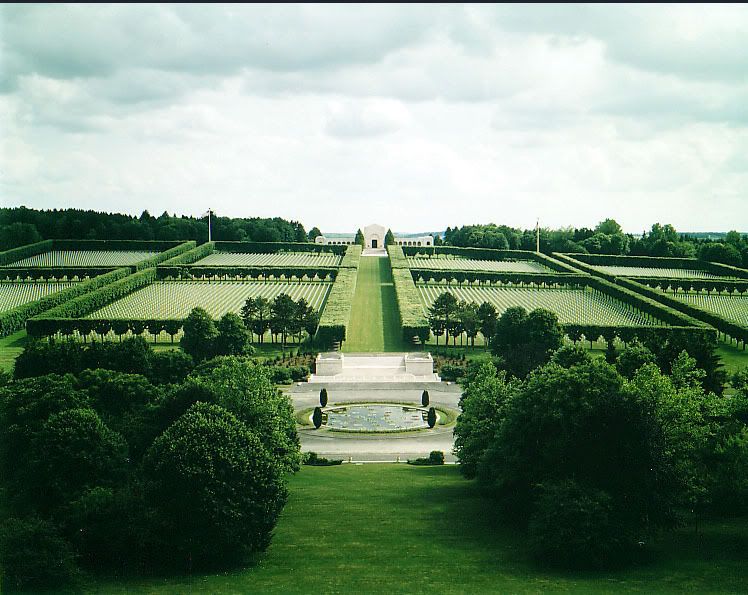 Within the Meuse-Argonne American Cemetery and Memorial in France, which covers 130.5 acres, rest the largest number of our military dead in Europe, a total of 14,246. Most of those buried here lost their lives during the Meuse-Argonne Offensive of World War I. The immense array of headstones rises in long regular rows upward beyond a wide central pool to the chapel that crowns the ridge. A beautiful bronze screen separates the chapel foyer from the interior, which is decorated with stained-glass windows portraying American unit insignia; behind the altar are flags of the principal Allied nations.
On either side of the chapel are memorial loggias. One panel of the west loggia contains a map of the Meuse-Argonne Offensive. Inscribed on the remaining panels of both loggias are Tablets of the Missing with 954 names, including those from the U.S. expedition to northern Russia in 1918-1919. Rosettes mark the names of those since recovered and identified.
The cemetery is open daily to the public from 9 a.m. to 5 p.m. except December 25 and January 1. It is open on host country holidays. When the cemetery is open to the public, a staff member is on duty in the Visitor Building to answer questions and escort relatives to grave and memorial sites.
How to Get There
Meuse-Argonne American Cemetery is located east of the village of Romagne-sous-Montfaucon (Meuse), France, which is 26 miles northwest of Verdun. It may be reached by automobile from Paris (152 miles) via toll autoroute A-4 or highway N-3, to Ste. Menehould, continuing on N-3 to Clermont-en-Argonne (19 miles south of the cemetery) and continuing via Varennes-en-Argonne. It may also be reached from Verdun, where hotels are available, via Consenvoye or Dun-sur-Meuse, distances of 26 or 29 miles. Rail service from Paris (Gare de l'Est) to Verdun takes about 3½ hours. Taxis are available from there to the cemetery.
Within the Meuse-Argonne American Cemetery and Memorial in France, which covers 130.5 acres, rest the largest number of our military dead in Europe, a total of 14,246. Most of those buried here lost their lives during the Meuse-Argonne Offensive of World War I. The immense array of headstones rises in long regular rows upward beyond a wide central pool to the chapel that crowns the ridge. A beautiful bronze screen separates the chapel foyer from the interior, which is decorated with stained-glass windows portraying American unit insignia; behind the altar are flags of the principal Allied nations.
On either side of the chapel are memorial loggias. One panel of the west loggia contains a map of the Meuse-Argonne Offensive. Inscribed on the remaining panels of both loggias are Tablets of the Missing with 954 names, including those from the U.S. expedition to northern Russia in 1918-1919. Rosettes mark the names of those since recovered and identified.
The cemetery is open daily to the public from 9 a.m. to 5 p.m. except December 25 and January 1. It is open on host country holidays. When the cemetery is open to the public, a staff member is on duty in the Visitor Building to answer questions and escort relatives to grave and memorial sites.
How to Get There
Meuse-Argonne American Cemetery is located east of the village of Romagne-sous-Montfaucon (Meuse), France, which is 26 miles northwest of Verdun. It may be reached by automobile from Paris (152 miles) via toll autoroute A-4 or highway N-3, to Ste. Menehould, continuing on N-3 to Clermont-en-Argonne (19 miles south of the cemetery) and continuing via Varennes-en-Argonne. It may also be reached from Verdun, where hotels are available, via Consenvoye or Dun-sur-Meuse, distances of 26 or 29 miles. Rail service from Paris (Gare de l'Est) to Verdun takes about 3½ hours. Taxis are available from there to the cemetery.

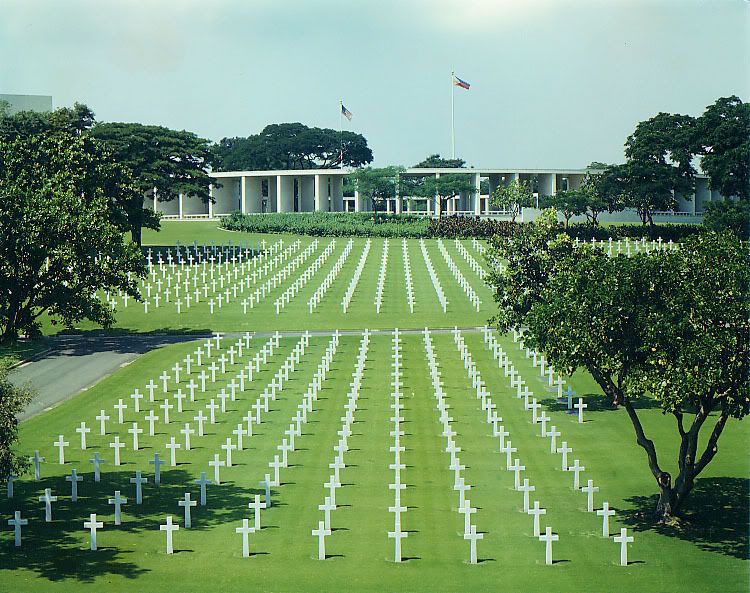 The Manila American Cemetery and Memorial in the Philippines occupies 152 acres on a prominent plateau, visible at a distance from the east, south and west. It contains the largest number of graves of our military dead of World War II, a total of 17,202, most of whom lost their lives in operations in New Guinea and the Philippines. The headstones are aligned in 11 plots forming a generally circular pattern, set among masses of a wide variety of tropical trees and shrubbery.
The chapel, a white masonry building enriched with sculpture and mosaic, stands near the center of the cemetery. In front of it on a wide terrace are two large hemicycles. Twenty-five mosaic maps recall the achievements of the American armed forces in the Pacific, China, India and Burma. On rectangular Trani limestone piers within the hemicycles are inscribed the Tablets of the Missing containing 36,285 names. Rosettes mark the names of those since recovered and identified. Carved in the floors are the seals of the American states and its territories. From the memorial and other points within the cemetery there are impressive views over the lowlands to Laguna de Bay and towards the distant mountains.
The cemetery is open daily to the public from 9 a.m. to 5 p.m. except December 25 and January 1. It is open on host country holidays. When the cemetery is open to the public, a staff member is on duty in the Visitor Building to answer questions and escort relatives to grave and memorial sites.
How to Get There
Manila American Cemetery is located in the Global City, Taguig, Metro Manila, within the boundaries of the former Fort William McKinley. It can be reached most easily from the city by taxi or automobile via Epifano de los Santos Ave. (EDSA) to McKinley Road, then to McKinley Parkway inside the Global City. The Nichols Field Road is the easiest access from Manila International Airport to the cemetery.
The Manila American Cemetery and Memorial in the Philippines occupies 152 acres on a prominent plateau, visible at a distance from the east, south and west. It contains the largest number of graves of our military dead of World War II, a total of 17,202, most of whom lost their lives in operations in New Guinea and the Philippines. The headstones are aligned in 11 plots forming a generally circular pattern, set among masses of a wide variety of tropical trees and shrubbery.
The chapel, a white masonry building enriched with sculpture and mosaic, stands near the center of the cemetery. In front of it on a wide terrace are two large hemicycles. Twenty-five mosaic maps recall the achievements of the American armed forces in the Pacific, China, India and Burma. On rectangular Trani limestone piers within the hemicycles are inscribed the Tablets of the Missing containing 36,285 names. Rosettes mark the names of those since recovered and identified. Carved in the floors are the seals of the American states and its territories. From the memorial and other points within the cemetery there are impressive views over the lowlands to Laguna de Bay and towards the distant mountains.
The cemetery is open daily to the public from 9 a.m. to 5 p.m. except December 25 and January 1. It is open on host country holidays. When the cemetery is open to the public, a staff member is on duty in the Visitor Building to answer questions and escort relatives to grave and memorial sites.
How to Get There
Manila American Cemetery is located in the Global City, Taguig, Metro Manila, within the boundaries of the former Fort William McKinley. It can be reached most easily from the city by taxi or automobile via Epifano de los Santos Ave. (EDSA) to McKinley Road, then to McKinley Parkway inside the Global City. The Nichols Field Road is the easiest access from Manila International Airport to the cemetery.
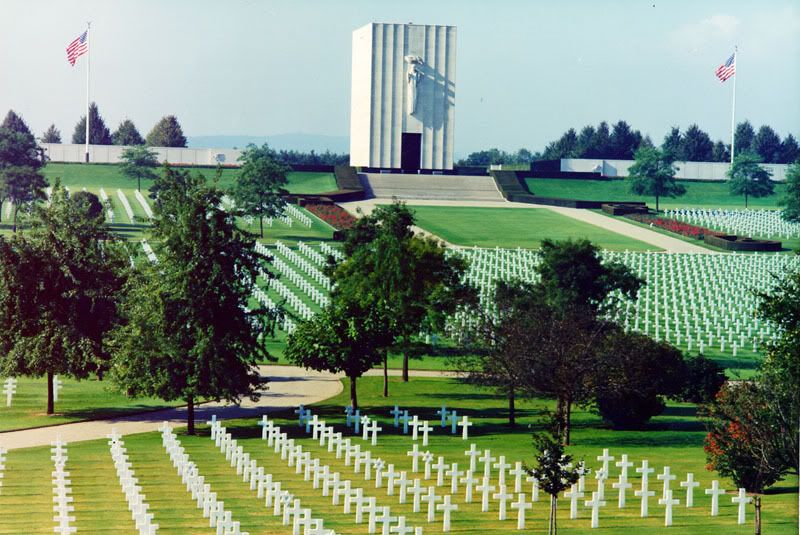 The Lorraine American Cemetery and Memorial in France covers 113.5 acres and contains the largest number of graves of our military dead of World War II in Europe, a total of 10,489. Their headstones are arranged in nine plots in a generally elliptical design extending over the beautiful rolling terrain of eastern Lorraine and culminating in a prominent overlook feature. Most of the dead here were killed while driving the German forces from the fortress city of Metz toward the Siegfried Line and the Rhine River. Initially, there were over 16,000 Americans interred in the St. Avold region, mostly from the U.S. Seventh Army's Infantry and Armored Divisions and its Cavalry Groups. St. Avold served as a vital communications center for the vast network of enemy defenses guarding the western border of the Third Reich.
The memorial, which stands on a plateau to the west of the burial area, contains ceramic operations maps with narratives and service flags. High on its exterior front wall is the large figure of St. Nabor, the martyred Roman soldier overlooking the silent host. On each side of the memorial, and parallel to its front, stretch the Tablets of the Missing on which are inscribed 444 names. Rosettes mark the names of those since recovered and identified. The entire area is framed in woodland.
The cemetery is open daily to the public from 9 a.m. to 5 p.m. except December 25 and January 1. It is open on host country holidays. When the cemetery is open to the public, a staff member is on duty in the Visitor Building to answer questions and escort relatives to grave and memorial sites.
How to Get There
Lorraine American Cemetery is situated ¾ mile north of the town of St. Avold (Moselle), France, on highway N-33. St. Avold, which is 28 miles east of Metz and 17 miles southwest of Saarbrücken, can be reached by automobile from Paris (220 miles) via toll autoroute A-4 in about 4 hours. Trains from Paris (Gare de l'Est) to St. Avold station, which is 3 miles from the town, take about 3½ hours. Taxicabs are available at the station. There are hotels at St. Avold, Forbach, Saarbrücken and Metz.
The Lorraine American Cemetery and Memorial in France covers 113.5 acres and contains the largest number of graves of our military dead of World War II in Europe, a total of 10,489. Their headstones are arranged in nine plots in a generally elliptical design extending over the beautiful rolling terrain of eastern Lorraine and culminating in a prominent overlook feature. Most of the dead here were killed while driving the German forces from the fortress city of Metz toward the Siegfried Line and the Rhine River. Initially, there were over 16,000 Americans interred in the St. Avold region, mostly from the U.S. Seventh Army's Infantry and Armored Divisions and its Cavalry Groups. St. Avold served as a vital communications center for the vast network of enemy defenses guarding the western border of the Third Reich.
The memorial, which stands on a plateau to the west of the burial area, contains ceramic operations maps with narratives and service flags. High on its exterior front wall is the large figure of St. Nabor, the martyred Roman soldier overlooking the silent host. On each side of the memorial, and parallel to its front, stretch the Tablets of the Missing on which are inscribed 444 names. Rosettes mark the names of those since recovered and identified. The entire area is framed in woodland.
The cemetery is open daily to the public from 9 a.m. to 5 p.m. except December 25 and January 1. It is open on host country holidays. When the cemetery is open to the public, a staff member is on duty in the Visitor Building to answer questions and escort relatives to grave and memorial sites.
How to Get There
Lorraine American Cemetery is situated ¾ mile north of the town of St. Avold (Moselle), France, on highway N-33. St. Avold, which is 28 miles east of Metz and 17 miles southwest of Saarbrücken, can be reached by automobile from Paris (220 miles) via toll autoroute A-4 in about 4 hours. Trains from Paris (Gare de l'Est) to St. Avold station, which is 3 miles from the town, take about 3½ hours. Taxicabs are available at the station. There are hotels at St. Avold, Forbach, Saarbrücken and Metz.
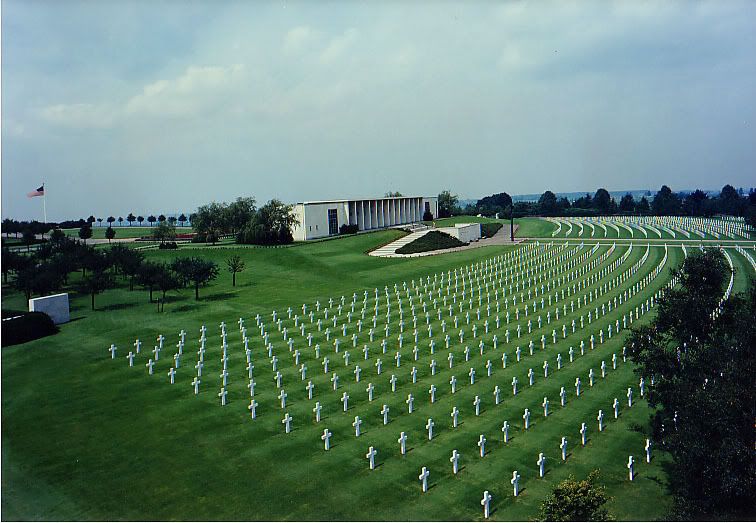 At the Henri-Chapelle American Cemetery and Memorial in Belgium, covering 57 acres, rest 7,992 of our military dead, most of whom lost their lives during the advance of the U.S. armed forces into Germany. Their headstones are arranged in gentle arcs sweeping across a broad green lawn that slopes gently downhill. A highway passes through the reservation. West of the highway an overlook affords an excellent view of the rolling Belgian countryside, once a battlefield.
To the east is the long colonnade that, with the chapel and map room, forms the memorial overlooking the burial area. The chapel is simple but richly ornamented. In the map room are two maps of military operations, carved in black granite, with inscriptions recalling the achievements of our forces. On the rectangular piers of the colonnade are inscribed the names of 450 missing. Rosettes mark the names of those since recovered and identified. The seals of the states and territories are also carved on these piers.
The cemetery possesses great military historic significance as it holds fallen Americans of two major efforts, one covering the U.S. First Army's drive in September 1944 through northern France, Belgium, Holland and Luxembourg into Germany, the second covering the Battle of the Bulge. It was from the temporary cemetery at Henri-Chapelle that the first shipments of remains of American war dead were returned to the U.S. for permanent burial. The repatriation program began on July 27, 1947 at a special ceremony at the cemetery when the disinterment began. The first shipment of 5,600 American war dead from Henri-Chapelle left Antwerp, Belgium the first week of October 1947. An impressive ceremony was held, with over 30,000 Belgium citizens attending along with representatives of the Belgium government and senior Americans.
The cemetery is open daily to the public from 9 a.m. to 5 p.m. except December 25 and January 1. It is open on host country holidays. When the cemetery is open to the public, a staff member is on duty in the Visitor Building to answer questions and escort relatives to grave and memorial sites.
How to Get There
Henri-Chapelle American Cemetery lies 2 miles northwest of the village of Henri-Chapelle, which is 4½ miles northwest of the Welkenraedt exit (7 miles from the German border) on the Aachen-Antwerp autoroute. Welkenraedt, the nearest train station to the cemetery, may be reached by train from Paris (Gare du Nord), Brussels and Aachen.
At the Henri-Chapelle American Cemetery and Memorial in Belgium, covering 57 acres, rest 7,992 of our military dead, most of whom lost their lives during the advance of the U.S. armed forces into Germany. Their headstones are arranged in gentle arcs sweeping across a broad green lawn that slopes gently downhill. A highway passes through the reservation. West of the highway an overlook affords an excellent view of the rolling Belgian countryside, once a battlefield.
To the east is the long colonnade that, with the chapel and map room, forms the memorial overlooking the burial area. The chapel is simple but richly ornamented. In the map room are two maps of military operations, carved in black granite, with inscriptions recalling the achievements of our forces. On the rectangular piers of the colonnade are inscribed the names of 450 missing. Rosettes mark the names of those since recovered and identified. The seals of the states and territories are also carved on these piers.
The cemetery possesses great military historic significance as it holds fallen Americans of two major efforts, one covering the U.S. First Army's drive in September 1944 through northern France, Belgium, Holland and Luxembourg into Germany, the second covering the Battle of the Bulge. It was from the temporary cemetery at Henri-Chapelle that the first shipments of remains of American war dead were returned to the U.S. for permanent burial. The repatriation program began on July 27, 1947 at a special ceremony at the cemetery when the disinterment began. The first shipment of 5,600 American war dead from Henri-Chapelle left Antwerp, Belgium the first week of October 1947. An impressive ceremony was held, with over 30,000 Belgium citizens attending along with representatives of the Belgium government and senior Americans.
The cemetery is open daily to the public from 9 a.m. to 5 p.m. except December 25 and January 1. It is open on host country holidays. When the cemetery is open to the public, a staff member is on duty in the Visitor Building to answer questions and escort relatives to grave and memorial sites.
How to Get There
Henri-Chapelle American Cemetery lies 2 miles northwest of the village of Henri-Chapelle, which is 4½ miles northwest of the Welkenraedt exit (7 miles from the German border) on the Aachen-Antwerp autoroute. Welkenraedt, the nearest train station to the cemetery, may be reached by train from Paris (Gare du Nord), Brussels and Aachen.
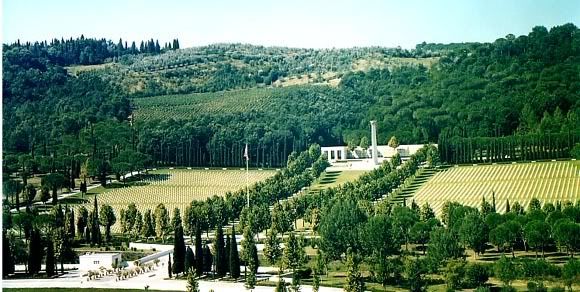 The Florence American Cemetery and Memorial site in Italy covers 70 acres, chiefly on the west side of the Greve "torrente." The wooded hills that frame its west limit rise several hundred feet. Between the two entrance buildings, a bridge leads to the burial area where the headstones of 4,402 of our military dead are arrayed in symmetrical curved rows upon the hillside. They represent 39 percent of the U.S. Fifth Army burials originally made between Rome and the Alps. Most died in the fighting that occurred after the capture of Rome in June 1944. Included among them are casualties of the heavy fighting in the Apennines shortly before the war's end. On May 2, 1945, the enemy troops in northern Italy surrendered.
Above the graves, on the topmost of three broad terraces, stands the memorial marked by a tall pylon surmounted by a large sculptured figure. The memorial has two open atria, or courts, joined by the Tablets of the Missing upon which are inscribed 1,409 names. Rosettes mark the names of those since recovered and identified. The atrium at the south end of the Tablets of the Missing serves as a forecourt to the chapel, which is decorated with marble and mosaic. The north atrium contains the marble operations maps recording the achievements of the American armed forces in this region.
The cemetery is open daily to the public from 9 a.m. to 5 p.m. except December 25 and January 1. It is open on host country holidays. When the cemetery is open to the public, a staff member is on duty in the Visitor Building to answer questions and escort relatives to grave and memorial sites.
How to Get There
Florence American Cemetery is located on the west side of Via Cassia, about 7½ miles south of Florence. The Rome-Milan A1 autostrada passes near the cemetery; its Certosa-Florence exit is 2 miles to the north. There is excellent train service to Florence from the principal cities of Italy; it is also served by some of the international trains. The "SITA" bus station provides frequent bus service along Via Cassia and there is a bus stop conveniently located just outside the cemetery gate.
The Florence American Cemetery and Memorial site in Italy covers 70 acres, chiefly on the west side of the Greve "torrente." The wooded hills that frame its west limit rise several hundred feet. Between the two entrance buildings, a bridge leads to the burial area where the headstones of 4,402 of our military dead are arrayed in symmetrical curved rows upon the hillside. They represent 39 percent of the U.S. Fifth Army burials originally made between Rome and the Alps. Most died in the fighting that occurred after the capture of Rome in June 1944. Included among them are casualties of the heavy fighting in the Apennines shortly before the war's end. On May 2, 1945, the enemy troops in northern Italy surrendered.
Above the graves, on the topmost of three broad terraces, stands the memorial marked by a tall pylon surmounted by a large sculptured figure. The memorial has two open atria, or courts, joined by the Tablets of the Missing upon which are inscribed 1,409 names. Rosettes mark the names of those since recovered and identified. The atrium at the south end of the Tablets of the Missing serves as a forecourt to the chapel, which is decorated with marble and mosaic. The north atrium contains the marble operations maps recording the achievements of the American armed forces in this region.
The cemetery is open daily to the public from 9 a.m. to 5 p.m. except December 25 and January 1. It is open on host country holidays. When the cemetery is open to the public, a staff member is on duty in the Visitor Building to answer questions and escort relatives to grave and memorial sites.
How to Get There
Florence American Cemetery is located on the west side of Via Cassia, about 7½ miles south of Florence. The Rome-Milan A1 autostrada passes near the cemetery; its Certosa-Florence exit is 2 miles to the north. There is excellent train service to Florence from the principal cities of Italy; it is also served by some of the international trains. The "SITA" bus station provides frequent bus service along Via Cassia and there is a bus stop conveniently located just outside the cemetery gate.
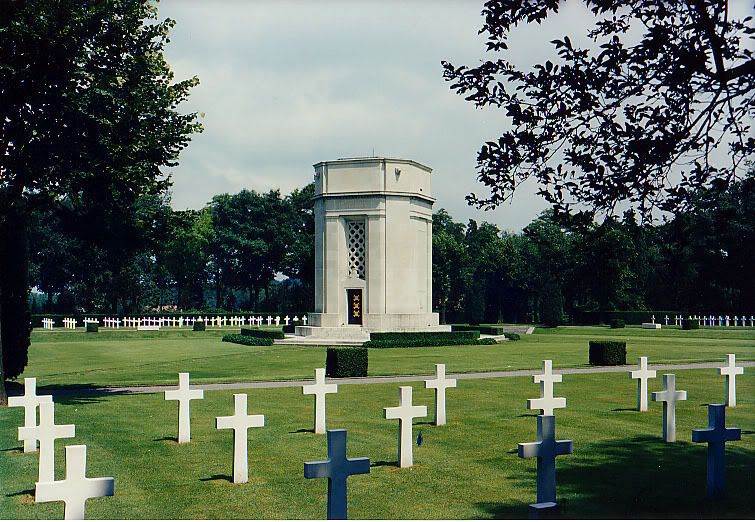 The Flanders Field American Cemetery and Memorial in Belgium occupies a 6.2-acre site. Masses of graceful trees and shrubbery frame the burial area and screen it from passing traffic. At the ends of the paths leading to three of the corners of the cemetery are circular retreats, with benches and urns. At this peaceful site rest 368 of our military dead, most of whom gave their lives in liberating the soil of Belgium in World War I. Their headstones are aligned in four symmetrical areas around the white stone chapel that stands in the center of the cemetery.
The altar inside the chapel is made of black and white "Grand Antique" marble with draped flags on each side; above it is a crusader's sword outlined in gold. The chapel furniture is of carved oak, stained black with white veining to harmonize with the altar; 43 names are inscribed on Walls of the Missing. Rosettes mark the names of those since recovered and identified.
The cemetery is open daily to the public from 9 a.m. to 5 p.m. except December 25 and January 1. It is open on host country holidays. When the cemetery is open to the public, a staff member is on duty in the Visitor Building to answer questions and escort relatives to grave and memorial sites.
How to Get There
Flanders Field American Cemetery lies on the southeast edge of the town of Waregem, Belgium, along the Lille-Gent Autoroute E-17. It is located 175 miles north of Paris and 52 miles west of Brussels. The cemetery is within 44 miles of Brugge (Brugges) and 22 miles of Gent, the two largest cities in Flanders. Waregem may be reached by train from Brussels via Gent (Gand) in approximately one hour; from Paris (Gare du Nord) in about five hours via Rijsel (Lille) and Kortrijk (Courtrai), and 5½ hours via Brussels and Gent. Taxi service is available from the train station in Waregem.
The Flanders Field American Cemetery and Memorial in Belgium occupies a 6.2-acre site. Masses of graceful trees and shrubbery frame the burial area and screen it from passing traffic. At the ends of the paths leading to three of the corners of the cemetery are circular retreats, with benches and urns. At this peaceful site rest 368 of our military dead, most of whom gave their lives in liberating the soil of Belgium in World War I. Their headstones are aligned in four symmetrical areas around the white stone chapel that stands in the center of the cemetery.
The altar inside the chapel is made of black and white "Grand Antique" marble with draped flags on each side; above it is a crusader's sword outlined in gold. The chapel furniture is of carved oak, stained black with white veining to harmonize with the altar; 43 names are inscribed on Walls of the Missing. Rosettes mark the names of those since recovered and identified.
The cemetery is open daily to the public from 9 a.m. to 5 p.m. except December 25 and January 1. It is open on host country holidays. When the cemetery is open to the public, a staff member is on duty in the Visitor Building to answer questions and escort relatives to grave and memorial sites.
How to Get There
Flanders Field American Cemetery lies on the southeast edge of the town of Waregem, Belgium, along the Lille-Gent Autoroute E-17. It is located 175 miles north of Paris and 52 miles west of Brussels. The cemetery is within 44 miles of Brugge (Brugges) and 22 miles of Gent, the two largest cities in Flanders. Waregem may be reached by train from Brussels via Gent (Gand) in approximately one hour; from Paris (Gare du Nord) in about five hours via Rijsel (Lille) and Kortrijk (Courtrai), and 5½ hours via Brussels and Gent. Taxi service is available from the train station in Waregem.
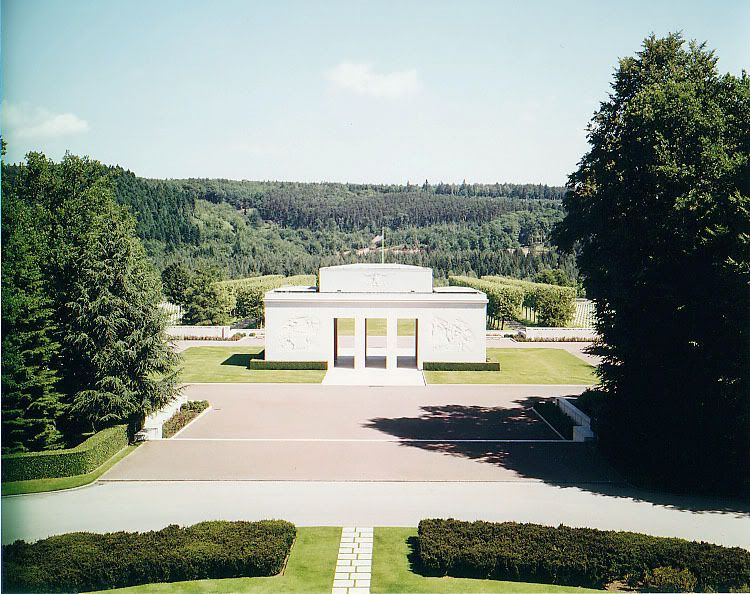 The Epinal American Cemetery and Memorial in France, 48.6 acres in extent, is sited on a plateau 100 feet above the Moselle River in the foothills of the Vosges Mountains. It contains the graves of 5,255 of our military dead, most of whom lost their lives in the campaigns across northeastern France to the Rhine and beyond into Germany. The cemetery was established in October 1944 by the 46th Quartermaster Graves Registration Company of the U.S. Seventh Army as it drove northward from southern France through the Rhone Valley into Germany. The cemetery became the repository for the fatalities in the bitter fighting through the Heasbourg Gap during the winter of 1944-45.
The memorial, a rectangular structure with two large bas-relief panels, consists of a chapel, portico, and map room with a mosaic operations map. On the walls of the Court of Honor, which surround the memorial, are inscribed the names of 424 of the missing. Rosettes mark the names of those since recovered and identified. Stretching northward is a wide, tree-lined mall that separates the two large burial plots. At the northern end of the mall, the circular flagpole plaza forms an overlook affording a view of a wide sweep of the Moselle Valley.
On May 12, 1958, thirteen caskets draped with American flags were placed side by side at the memorial. Each casket contained the remains of one World War II Unknown American, one from each of the thirteen permanent American military cemeteries in the European Theater of Operations. In a solemn ceremony, General Edward J. O'Neill, Commanding General of the U.S. Army Communication Zone, Europe, selected the Unknown to represent the European Theater. It was flown to Naples, Italy and placed with Unknowns from the Atlantic and Pacific Theaters of Operation aboard the USS Blandy for transportation to Washington, D.C. for final selection of the Unknown from World War II. On Memorial Day, 1958, the remains were buried alongside the Unknown from World War I at the Tomb of the Unknown Soldier at Arlington National Cemetery.
The cemetery is open daily to the public from 9 a.m. to 5 p.m. except December 25 and January 1. It is open on host country holidays. When the cemetery is open to the public, a staff member is on duty in the Visitor Building to answer questions and escort relatives to grave and memorial sites.
How to Get There
Epinal American Cemetery is located approximately 4 miles (7 kilometers) southeast of Epinal (Vosges), France, on road D-157, in the village of Dinoze-Quèquement. It can be reached by automobile from Paris (231 miles) in about 5 hours via toll autoroute A-4, eastward to the Nancy exit, then highway N-57. Avoid the city of Epinal and exit only at Arches-Dinoze. Rail service is available from the Gare de l'Est, Paris via Nancy, where it may be necessary to change trains. The journey by train also requires about 5 hours. Air travel service is available from Paris to the Epinal-Mirecourt Airport. Travel by air takes about 45 minutes. Adequate hotel accommodations and taxi service can be found in Epinal and vicinity.
The Epinal American Cemetery and Memorial in France, 48.6 acres in extent, is sited on a plateau 100 feet above the Moselle River in the foothills of the Vosges Mountains. It contains the graves of 5,255 of our military dead, most of whom lost their lives in the campaigns across northeastern France to the Rhine and beyond into Germany. The cemetery was established in October 1944 by the 46th Quartermaster Graves Registration Company of the U.S. Seventh Army as it drove northward from southern France through the Rhone Valley into Germany. The cemetery became the repository for the fatalities in the bitter fighting through the Heasbourg Gap during the winter of 1944-45.
The memorial, a rectangular structure with two large bas-relief panels, consists of a chapel, portico, and map room with a mosaic operations map. On the walls of the Court of Honor, which surround the memorial, are inscribed the names of 424 of the missing. Rosettes mark the names of those since recovered and identified. Stretching northward is a wide, tree-lined mall that separates the two large burial plots. At the northern end of the mall, the circular flagpole plaza forms an overlook affording a view of a wide sweep of the Moselle Valley.
On May 12, 1958, thirteen caskets draped with American flags were placed side by side at the memorial. Each casket contained the remains of one World War II Unknown American, one from each of the thirteen permanent American military cemeteries in the European Theater of Operations. In a solemn ceremony, General Edward J. O'Neill, Commanding General of the U.S. Army Communication Zone, Europe, selected the Unknown to represent the European Theater. It was flown to Naples, Italy and placed with Unknowns from the Atlantic and Pacific Theaters of Operation aboard the USS Blandy for transportation to Washington, D.C. for final selection of the Unknown from World War II. On Memorial Day, 1958, the remains were buried alongside the Unknown from World War I at the Tomb of the Unknown Soldier at Arlington National Cemetery.
The cemetery is open daily to the public from 9 a.m. to 5 p.m. except December 25 and January 1. It is open on host country holidays. When the cemetery is open to the public, a staff member is on duty in the Visitor Building to answer questions and escort relatives to grave and memorial sites.
How to Get There
Epinal American Cemetery is located approximately 4 miles (7 kilometers) southeast of Epinal (Vosges), France, on road D-157, in the village of Dinoze-Quèquement. It can be reached by automobile from Paris (231 miles) in about 5 hours via toll autoroute A-4, eastward to the Nancy exit, then highway N-57. Avoid the city of Epinal and exit only at Arches-Dinoze. Rail service is available from the Gare de l'Est, Paris via Nancy, where it may be necessary to change trains. The journey by train also requires about 5 hours. Air travel service is available from Paris to the Epinal-Mirecourt Airport. Travel by air takes about 45 minutes. Adequate hotel accommodations and taxi service can be found in Epinal and vicinity. The Cambridge American Cemetery and Memorial site in England, 30.5 acres in total, was donated by the University of Cambridge. It lies on a slope with the west and south sides framed by woodland. The cemetery contains the remains of 3,812 of our military dead; 5,127 names are recorded on the Tablets of the Missing. Rosettes mark the names of those since recovered and identified. Most died in the Battle of the Atlantic or in the strategic air bombardment of northwest Europe.
From the flagpole platform near the main entrance, the great mall with its reflecting pools stretches eastward. It is from the mall that the wide, sweeping curve of the burial area across the green lawns is best appreciated. Along the south side are the Tablets of the Missing, and at the far end is the memorial with its chapel, two huge military maps, stained-glass windows bearing the state seals and military decorations, and mosaic ceiling memorial to the dead of our air forces.
The cemetery is open daily to the public from 9 a.m. to 5 p.m. except December 25 and January 1. It is open on host country holidays. When the cemetery is open to the public, a staff member is on duty in the Visitor Building to answer questions and escort relatives to grave and memorial sites.
How to Get There
Cambridge American Cemetery is situated 3 miles west of the university city of Cambridge, England, on highway A-1303 and 60 miles north of London. By automobile from London it takes less than 2 hours. Cambridge may also be reached by railroad from King's Cross and Liverpool Street stations. Travel time is about 1 hour; train service is frequent. Taxicab service is available at Cambridge station. There are excellent hotels in the city.
The Cambridge American Cemetery and Memorial site in England, 30.5 acres in total, was donated by the University of Cambridge. It lies on a slope with the west and south sides framed by woodland. The cemetery contains the remains of 3,812 of our military dead; 5,127 names are recorded on the Tablets of the Missing. Rosettes mark the names of those since recovered and identified. Most died in the Battle of the Atlantic or in the strategic air bombardment of northwest Europe.
From the flagpole platform near the main entrance, the great mall with its reflecting pools stretches eastward. It is from the mall that the wide, sweeping curve of the burial area across the green lawns is best appreciated. Along the south side are the Tablets of the Missing, and at the far end is the memorial with its chapel, two huge military maps, stained-glass windows bearing the state seals and military decorations, and mosaic ceiling memorial to the dead of our air forces.
The cemetery is open daily to the public from 9 a.m. to 5 p.m. except December 25 and January 1. It is open on host country holidays. When the cemetery is open to the public, a staff member is on duty in the Visitor Building to answer questions and escort relatives to grave and memorial sites.
How to Get There
Cambridge American Cemetery is situated 3 miles west of the university city of Cambridge, England, on highway A-1303 and 60 miles north of London. By automobile from London it takes less than 2 hours. Cambridge may also be reached by railroad from King's Cross and Liverpool Street stations. Travel time is about 1 hour; train service is frequent. Taxicab service is available at Cambridge station. There are excellent hotels in the city.
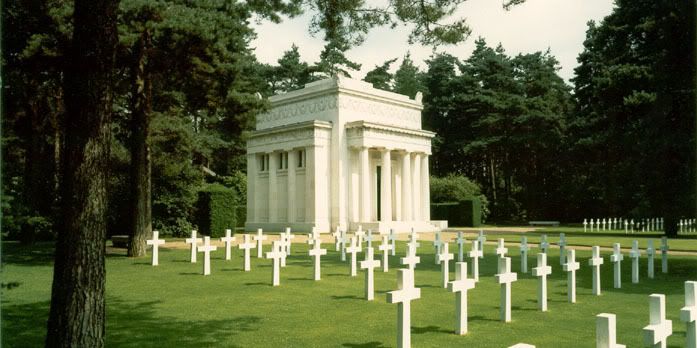 The 4.5 acre Brookwood American Cemetery and Memorial in England lies to the west of the large civilian cemetery built by the London Necropolis Co. and contains the graves of 468 of our military dead. Close by are military cemeteries and monuments of the British Commonwealth and other allied nations. Automobiles may drive through the Commonwealth or civilian cemeteries to the American cemetery.
Within the American cemetery the headstones are arranged in four plots, grouped about the flagpole. The regular rows of white marble headstones on the smooth lawn are framed by masses of shrubs and evergreen trees which form a perfect setting for the chapel, a classic white stone building on the north end of the cemetery. The interior of the chapel is of tan-hued stone. Small stained-glass windows light the altar and flags and the carved cross above them. On the walls within the chapel are inscribed the names of 563 of the missing. Rosettes mark the names of those since recovered and identified.
The cemetery is open daily to the public from 9 a.m. to 5 p.m. except December 25 and January 1. It is open on host country holidays. When the cemetery is open to the public, a staff member is on duty in the Visitor Building to answer questions and escort relatives to grave and memorial sites.
How to Get There
Brookwood American Cemetery is located directly south of the town of Brookwood, Surrey, England, 7 miles northwest of Guildford, and 9 miles northeast of Aldershot. It may be reached by automobile from London, a distance of 28 miles, or by train from Waterloo station in less than 45 minutes. The American cemetery is about 300 yards west of the Brookwood railroad station. There are hotels and restaurants at Woking, Guildford, Aldershot and other nearby towns.
The 4.5 acre Brookwood American Cemetery and Memorial in England lies to the west of the large civilian cemetery built by the London Necropolis Co. and contains the graves of 468 of our military dead. Close by are military cemeteries and monuments of the British Commonwealth and other allied nations. Automobiles may drive through the Commonwealth or civilian cemeteries to the American cemetery.
Within the American cemetery the headstones are arranged in four plots, grouped about the flagpole. The regular rows of white marble headstones on the smooth lawn are framed by masses of shrubs and evergreen trees which form a perfect setting for the chapel, a classic white stone building on the north end of the cemetery. The interior of the chapel is of tan-hued stone. Small stained-glass windows light the altar and flags and the carved cross above them. On the walls within the chapel are inscribed the names of 563 of the missing. Rosettes mark the names of those since recovered and identified.
The cemetery is open daily to the public from 9 a.m. to 5 p.m. except December 25 and January 1. It is open on host country holidays. When the cemetery is open to the public, a staff member is on duty in the Visitor Building to answer questions and escort relatives to grave and memorial sites.
How to Get There
Brookwood American Cemetery is located directly south of the town of Brookwood, Surrey, England, 7 miles northwest of Guildford, and 9 miles northeast of Aldershot. It may be reached by automobile from London, a distance of 28 miles, or by train from Waterloo station in less than 45 minutes. The American cemetery is about 300 yards west of the Brookwood railroad station. There are hotels and restaurants at Woking, Guildford, Aldershot and other nearby towns.